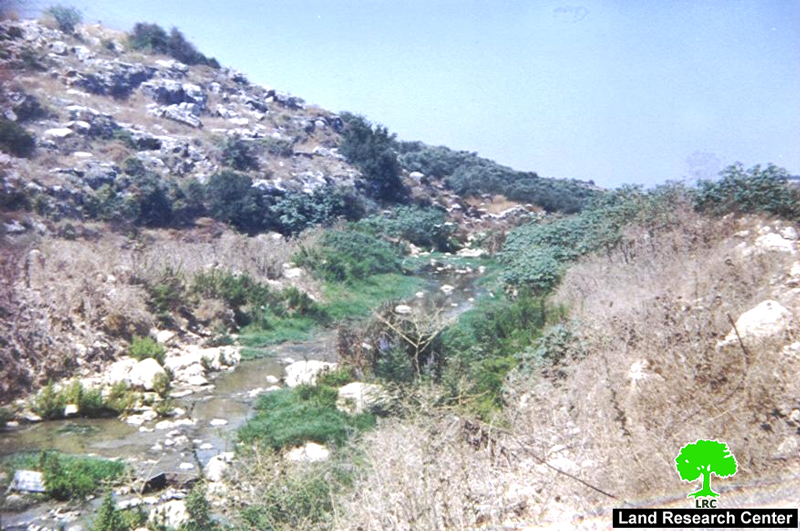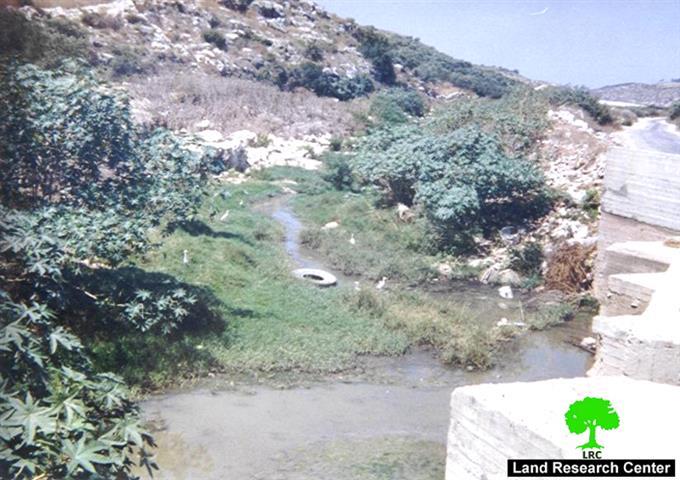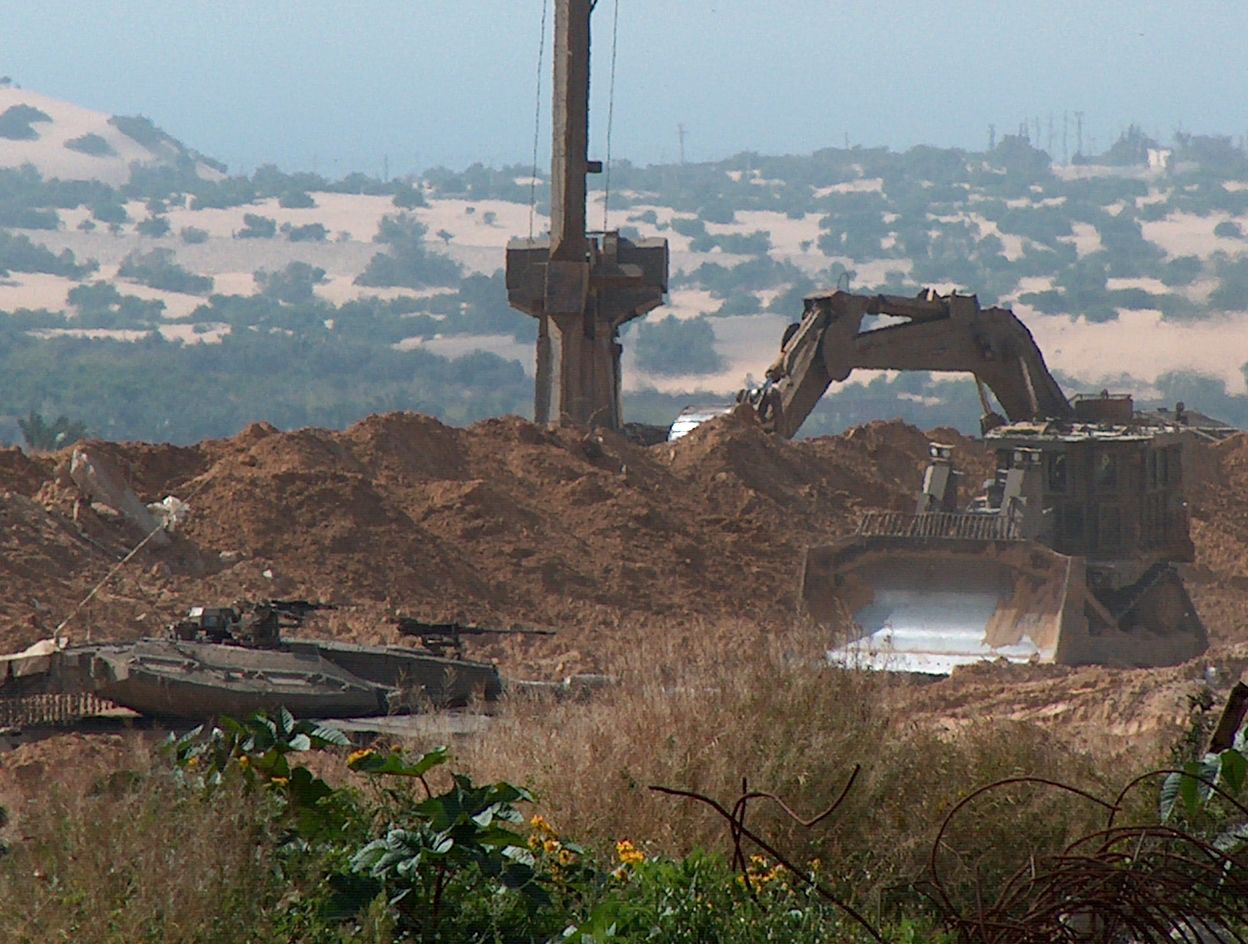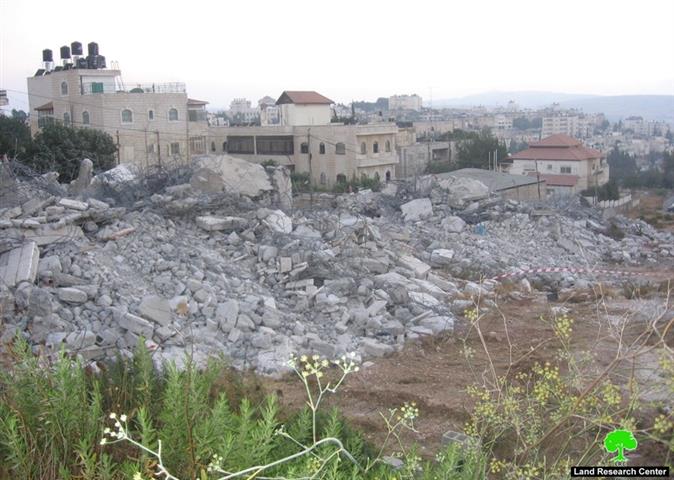Photo 1: Wadi Beit Amin, Qalqiliya: Palestinian agricultural land flooded
with swage water from Israeli settlements
Waste and swage water pouring from Israeli settlements has transformed Wadi Beit Amin, Qalqiliya governorate, from being a home for wild plants and birds' nests into a highly polluted area. Local people say that not very long time ago the Wadi has been a source of sweet smelling resurrected from Laurel and Alteon plants and served as a tourist attraction for the people of the area. Currently, it has become a source of bad smelling and home of insects, mosquito and flies as a stream of Waste and swage water flows at the bottom of the Wadi.
The Beit Amin Wadi is a continuation of a big Wadi, which starts near Hawara village, Nablus governorate in the east and goes down through Wadi Qana in Salfit governorate until it reaches the Mediterranean in the west passing by the Palestinian villages of Beit Amin, Azzun Atma and Ezbat Salman. It is about 10-20 meters wide by 2-4 meters deep. It was one of the most beautiful valleys in the region because of its nice scenery and attractive nature. The Wadi serves as a natural water flow for winter rain falling in a number of sub-valleys which meet to form this big valley of Beit Amin. It is free of water except during the wintertime when it gets flooded whenever there is heavy rain causing damage to agriculture and, sometimes, inflicting human losses. See Map 1
Map prepared by GIS unit-LRC
In an interview with LRC field worker, the head of Beit Amin village council said that the people of the area used to pleasure themselves by going on picnic and sight seeing tours in the valley where many beautiful orange groves are located, in addition to many other types of fruitful trees, greeneries, birds and animals. Since the establishment of the settlement of Sha'are Tikva in 1982 and the settlementof Ornait in 1984 the Wadi has been suffering serious ecological hazards because of contamination caused by these two settlements.
This problem was particularly aggravated in the past two years after the erection of a main wastewater line at the bottom of the valley for serving the Israeli settlements in the region where a high percentage of leakage occurs.
Sha'are Tikva and Oranit settlements
Sha'are Tikva started in 1982 as a small nucleus built over lands confiscated from the village of Azzun Atma, Qalqiliya governorate. By time, it expanded over an additional 200 dunums of lands seized from the villages of Beit Amin, Siniriya, Masha and az Zawiya in Qalqiliya and Salfit governorates. Nowadays, more than 18000 Palestinians residents of the area are badly affected by the settlement in away or another. The settlement's total population reached 3685 in the year 2004, and its municipal area was 1045 dunums of which 915 dunums are built up area (source- Foundation for Middle East Peace.)

(Photo 2: The settlement of Sha'are Tikva to the right hand side of the road)
Oranit began in 1984 over lands confiscated from Azzun Atma. In 2004, it had the population of 5458 settlers. The whole of its municipal land area of 878 dunums is built up area. Together, the two settlements are considered amongst the big settlements in the northern region of the West Bank.
Underground water affected
The settlement's gray and sewage water which pours in Wadi Beit Amin is a source of contamination and pollution for the existing soil and underground water. There are two underground wells in the valley used for domestic and agricultural purposes:
1. The well of Al 'Abeet in Beit Amin, which produces 60 M3 per one hour and;
2. The well of As Salman,which produces 60 M3 per one hour.
These two wells are susceptible to pollution due to their close location to the swage conduit.
At wintertime when the valley is flooded with rainwater the Israeli settlers take advantage to pour more sewage water into the flow causing large scale pollution to agriculture in the area, especially to ground irrigated crops and orange groves.

(Photo 3: one of the green houses affected by pollution)
Over use of pesticides
Farmer Sidqi Abdullah Saleh owns 5 dunums of green houses located in the Wadi of Beit Amin and are the only source of livelihood for his family after loosing his job inside Israel. He confirmed to our LRC field worker that because of the concentration of insects in the valley he is obliged to spend big amounts of money on buying insecticides which, on one hand, increases his financial losses, and, on the other hand, reduces the quality of products and aggravates soil degradation.


Photo 4 & Photo 5: Sewage water flows at the bottom of Wadi Beit Amin, Qalqiliya
Failure to do any thing
The Wadi was visited by many local and international organizations, such as the International Committee of the Red Cross, Red Crescent Society, Israeli human rights organization (Betselem) to assess the problem, but have done nothing to curb the Israeli authorities. In the meanwhile, local village councils and affected people had filed a number of complaints to the Israeli Supreme Court, the latest of which was in last March, but all in vain. On the contrary, the Israeli settlers have shown no restraint by continuing to pour more quantities of waste and sewage water in the Wadi during the past two months.
Prepared by
The Land Research Center
LRC















